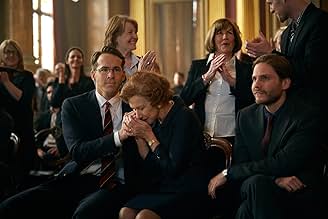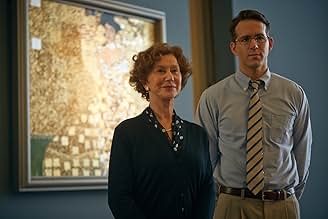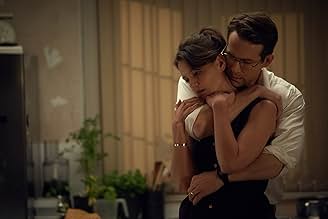IMDb-BEWERTUNG
7,3/10
65.188
IHRE BEWERTUNG
Maria Altmann, eine achtzigjährige jüdische Emigrantin, nimmt es mit der österreichischen Regierung auf, um Kunstwerke zurückzuerlangen, die ihrer Meinung nach rechtmäßig ihrer Familie gehör... Alles lesenMaria Altmann, eine achtzigjährige jüdische Emigrantin, nimmt es mit der österreichischen Regierung auf, um Kunstwerke zurückzuerlangen, die ihrer Meinung nach rechtmäßig ihrer Familie gehören.Maria Altmann, eine achtzigjährige jüdische Emigrantin, nimmt es mit der österreichischen Regierung auf, um Kunstwerke zurückzuerlangen, die ihrer Meinung nach rechtmäßig ihrer Familie gehören.
- Regie
- Drehbuch
- Hauptbesetzung
- Auszeichnungen
- 6 Nominierungen insgesamt
Empfohlene Bewertungen
This film tells the story of a old woman who moved to USA to escaped Nazi rule in Austria when she was young. She finds documentary proof in her late sister's belongings that several priceless paintings are stolen from her family, and are now in the possession of a state museum.
"Woman in Gold" is a beautiful film because it's a journey of three people working hard for a common goal for slightly different reasons. I'm impressed by the lawyer's enthusiasm in taking up Maria's case. He shows much dedication and professionalism. Maria's goal to take back the paintings is to keep memories alive, which is very touching. The atmosphere of the film is kept quite serious but not sombre, which is not easy for a film about the persecution of Jews. Overall, I think this film portrays a triumphant journey, and is very touching.
"Woman in Gold" is a beautiful film because it's a journey of three people working hard for a common goal for slightly different reasons. I'm impressed by the lawyer's enthusiasm in taking up Maria's case. He shows much dedication and professionalism. Maria's goal to take back the paintings is to keep memories alive, which is very touching. The atmosphere of the film is kept quite serious but not sombre, which is not easy for a film about the persecution of Jews. Overall, I think this film portrays a triumphant journey, and is very touching.
Helen Mirren and Ryan Reynolds star in "Woman in Gold" from 2015, a true story about the quest of Maria Altmann to recover art stolen from her family by the Nazis in Vienna, the seat of anti-Semitism in Europe.
I just want to point out, to answer some of the reviews, that this is not a documentary, it's a movie. Movies combine events, change them around, omit them. No one wants to watch a tedious film that recognizes that it took a huge amount of time to get to the Supreme Court. If you want the actual, factual story of Maria Altmann's journey, you will need to read about it or see one of several documentaries. Films are meant to pique our interest.
Altmann speaks with a young attorney, Randy Shoenberg, about recovering The Woman in Gold, a painting by Klimt that is considered a symbol of Vienna. Klimt in fact painted a series of stunning portraits of Altmann's aunt, Adele Bloch-Bauer, who died of meningitis at the age of 44.
In her will, she asked her husband Ferdinand, who had seen the writing on the wall in Vienna and fled to Prague, to donate the paintings to the Austrian State Gallery.
Although he has just started a new job, Shoenberg travels to Vienna to see the will. Along the way there are flashbacks of Vienna in the '30s, where the Bloch-Bauer family lived in opulence. When the Nazis came to their home, they stripped the place of everything valuable - and there was a lot -- and put the family under house arrest.
Maria and her husband, an opera singer, manage to escape in a harrowing scene. In flashbacks, Maria is played by the remarkable Tatiana Maslany, the star of "Orphan Black," who looks incredibly like a brunette Mirren.
This is a touching, beautifully told story of one man's sacrifice and determination and a woman facing up to her past in order to seek justice.
Helen Mirren is one of my favorite actresses - here, she is a vibrant, energetic octogenarian who finds the struggle for the painting uncomfortable - several times, meeting a roadblock, she is ready to wash her hands of it, but Schoenberg won't let her. It represents her family to her, and some uncomfortable memories. You can see all of that in Mirren's multilayered performance.
Reynolds is excellent as a young man who believes in taking a chance - - he started and failed in his own law practice - and in this case, going for the gold, despite the fact that he has a wife (Katie Holmes), a baby, and one on the way, and an intolerant boss. It doesn't faze him and when Maria wants to quit, he is furious.
I disagree that there was no connection between them. In fact, there is a deep one. The quest for the painting comes to represent to him what it means to Maria
I highly recommend this film. There are tons of movies about the horrors perpetrated on Jews by the Nazis. The recovery of stolen art is one part of that horror. "You see a painting," she tells a group. "I see my aunt."
I just want to point out, to answer some of the reviews, that this is not a documentary, it's a movie. Movies combine events, change them around, omit them. No one wants to watch a tedious film that recognizes that it took a huge amount of time to get to the Supreme Court. If you want the actual, factual story of Maria Altmann's journey, you will need to read about it or see one of several documentaries. Films are meant to pique our interest.
Altmann speaks with a young attorney, Randy Shoenberg, about recovering The Woman in Gold, a painting by Klimt that is considered a symbol of Vienna. Klimt in fact painted a series of stunning portraits of Altmann's aunt, Adele Bloch-Bauer, who died of meningitis at the age of 44.
In her will, she asked her husband Ferdinand, who had seen the writing on the wall in Vienna and fled to Prague, to donate the paintings to the Austrian State Gallery.
Although he has just started a new job, Shoenberg travels to Vienna to see the will. Along the way there are flashbacks of Vienna in the '30s, where the Bloch-Bauer family lived in opulence. When the Nazis came to their home, they stripped the place of everything valuable - and there was a lot -- and put the family under house arrest.
Maria and her husband, an opera singer, manage to escape in a harrowing scene. In flashbacks, Maria is played by the remarkable Tatiana Maslany, the star of "Orphan Black," who looks incredibly like a brunette Mirren.
This is a touching, beautifully told story of one man's sacrifice and determination and a woman facing up to her past in order to seek justice.
Helen Mirren is one of my favorite actresses - here, she is a vibrant, energetic octogenarian who finds the struggle for the painting uncomfortable - several times, meeting a roadblock, she is ready to wash her hands of it, but Schoenberg won't let her. It represents her family to her, and some uncomfortable memories. You can see all of that in Mirren's multilayered performance.
Reynolds is excellent as a young man who believes in taking a chance - - he started and failed in his own law practice - and in this case, going for the gold, despite the fact that he has a wife (Katie Holmes), a baby, and one on the way, and an intolerant boss. It doesn't faze him and when Maria wants to quit, he is furious.
I disagree that there was no connection between them. In fact, there is a deep one. The quest for the painting comes to represent to him what it means to Maria
I highly recommend this film. There are tons of movies about the horrors perpetrated on Jews by the Nazis. The recovery of stolen art is one part of that horror. "You see a painting," she tells a group. "I see my aunt."
Greetings again from the darkness. The responsibility of the filmmaker when the project is "based on a true story" is elevated when the story has significant historical relevance and blends such elements as art, identity, justice and international law. Add to those the quest of a remarkable woman whose family was ripped apart by Nazi insurgents, and more than a history lesson, it becomes a poignant personal story.
Helen Mirren portrays Maria Altmann, the woman who emigrated to the United States by fleeing her Austrian homeland during World War II, and leaving behind her beloved family and all possessions. After the death of her sister, Ms. Altmann becomes aware of the family artwork stolen by the Nazi's during the invasion. This is not just any artwork, but multiple pieces from famed Austrian artist Gustav Klimt including "Portrait of Adele Bloch-Bauer". See, Adele was Maria's aunt, and the stunning piece (with gold leaf accents) has become "the Mona Lisa of Austria", while hanging for decades in the state gallery.
The story revolves around Maria's partnering with family friend and upstart attorney Randol Schoenberg (Ryan Reynolds) to take on the nation of Austria and reclaim the (extremely valuable) artwork that was seized illegally so many years ago. They are aided in their mission by an Austrian journalist (played by Daniel Bruhl) who is fighting his own demons. The seven-plus year legal saga is condensed for the big screen and we follow Maria and Randol as they meet with the Austrian art reclamation committee, a federal judge (played by the director's wife Elizabeth McGovern), the U.S. Supreme Court (Jonathan Pryce as Chief Justice), and finally a mediation committee back in Austria. But this is not really a courtroom drama it's a personal quest for justice and search for identity. What role does family roots and history play in determining who we are today? It's the age old question of past vs. present, only this is seen through the eyes of a woman who has survived what most of us can only imagine.
Director Simon Curtis (My Week with Marilyn) uses startling flashbacks (with Tatiana Maslany as the younger Maria) to provide glimpses of Maria's childhood through her marriage and subsequent escape. We get to know her family, including some scenes featuring Aunt Adele (Antje Traue), and Maria's father and uncle (Henry Goodman, Allan Corduner). We understand this family's place in society and just how dramatically they were impacted by the Nazi takeover.
Helen Mirren delivers yet another exceptional performance and manages to pull off the snappy lines without an ounce of schmaltz, while also capturing the emotional turmoil Ms. Altmann endures. Director Curtis and writer Alexi Kaye Campbell round off some of the rough edges and inject enough humor to prevent this from being the gut-wrenching process it probably was in real life. This approach makes the film, the story and the characters more relatable for most movie goers and it's quite an enjoyable look at a fascinating woman and a pretty remarkable underdog story.
Helen Mirren portrays Maria Altmann, the woman who emigrated to the United States by fleeing her Austrian homeland during World War II, and leaving behind her beloved family and all possessions. After the death of her sister, Ms. Altmann becomes aware of the family artwork stolen by the Nazi's during the invasion. This is not just any artwork, but multiple pieces from famed Austrian artist Gustav Klimt including "Portrait of Adele Bloch-Bauer". See, Adele was Maria's aunt, and the stunning piece (with gold leaf accents) has become "the Mona Lisa of Austria", while hanging for decades in the state gallery.
The story revolves around Maria's partnering with family friend and upstart attorney Randol Schoenberg (Ryan Reynolds) to take on the nation of Austria and reclaim the (extremely valuable) artwork that was seized illegally so many years ago. They are aided in their mission by an Austrian journalist (played by Daniel Bruhl) who is fighting his own demons. The seven-plus year legal saga is condensed for the big screen and we follow Maria and Randol as they meet with the Austrian art reclamation committee, a federal judge (played by the director's wife Elizabeth McGovern), the U.S. Supreme Court (Jonathan Pryce as Chief Justice), and finally a mediation committee back in Austria. But this is not really a courtroom drama it's a personal quest for justice and search for identity. What role does family roots and history play in determining who we are today? It's the age old question of past vs. present, only this is seen through the eyes of a woman who has survived what most of us can only imagine.
Director Simon Curtis (My Week with Marilyn) uses startling flashbacks (with Tatiana Maslany as the younger Maria) to provide glimpses of Maria's childhood through her marriage and subsequent escape. We get to know her family, including some scenes featuring Aunt Adele (Antje Traue), and Maria's father and uncle (Henry Goodman, Allan Corduner). We understand this family's place in society and just how dramatically they were impacted by the Nazi takeover.
Helen Mirren delivers yet another exceptional performance and manages to pull off the snappy lines without an ounce of schmaltz, while also capturing the emotional turmoil Ms. Altmann endures. Director Curtis and writer Alexi Kaye Campbell round off some of the rough edges and inject enough humor to prevent this from being the gut-wrenching process it probably was in real life. This approach makes the film, the story and the characters more relatable for most movie goers and it's quite an enjoyable look at a fascinating woman and a pretty remarkable underdog story.
The lady in question is Adele Bloch-Bauer who was the subject of a magnificent painting, deploying lots of gold, by the Austrian artist Gustav Klimt. Following the Anschuss of 1938 when Germany took over Austria, this painting was one of many, many artefacts seized by the Nazis from Jewish families in occupied Europe.
The film tells the story - a little fictionalised - of Adele's niece Maria Altmann who escaped from Vienna to live in California and, during the 1980s as an octogenarian, pursued an audacious claim to take back this painting and other Klimt works from the Austrian Government. Helen Mirren is brilliant as Altmann in another distinguished performance in a sparkling career during which she has played everything from "The Queen" to an assassin (RED"), while Ryan Reynolds is surprisingly good as her lawyer Randy Schoenberg in a role a million miles from "Green Lantern" or "Deadpool".
There's a lot going on in this film: legal battles over the art work with some classic courtroom scenes, flashbacks (in sepia colours) to Altmann's earlier life in 1930s Vienna, and an evolving relationship between the irascible Altmann and the idealistic Schoenberg, both descendants of famous Austrians. This is not the kind of film that was ever going to be a major box office draw but it is certainly worth a home viewing.
The film tells the story - a little fictionalised - of Adele's niece Maria Altmann who escaped from Vienna to live in California and, during the 1980s as an octogenarian, pursued an audacious claim to take back this painting and other Klimt works from the Austrian Government. Helen Mirren is brilliant as Altmann in another distinguished performance in a sparkling career during which she has played everything from "The Queen" to an assassin (RED"), while Ryan Reynolds is surprisingly good as her lawyer Randy Schoenberg in a role a million miles from "Green Lantern" or "Deadpool".
There's a lot going on in this film: legal battles over the art work with some classic courtroom scenes, flashbacks (in sepia colours) to Altmann's earlier life in 1930s Vienna, and an evolving relationship between the irascible Altmann and the idealistic Schoenberg, both descendants of famous Austrians. This is not the kind of film that was ever going to be a major box office draw but it is certainly worth a home viewing.
It was a good choice after I have read all the positive critics here. This is a very emotional true story that is well told and never boring. There were good flashbacks where all the reconstructed scenes were originally and perfectly done. I felt to be in the movie. All the actors and especially Ryan Reynolds delivered a great job. Helen Mirren put as usual a special humor note into the ambiance. It seems this role is suited to her and nobody else. The music was wonderful and I had even some tears. This movie is much more better than the other ones about the stolen Jewish paintings from the Nazi. See it. 7/10
If you like this genre of movie don't miss The Pianist, Der Letzte Zug or Die Fälscher.
If you like this genre of movie don't miss The Pianist, Der Letzte Zug or Die Fälscher.
Wusstest du schon
- WissenswertesOprah Winfrey was, for ten years, the owner of Gustav Klimt's second-most-famous portrait of the subject of the painting unofficially known as "Woman in Gold." The second most famous Klimt portrait of Bloch-Bauer was officially titled "Adele Bloch-Bauer ll." Winfrey reportedly bought the painting anonymously in 2006, when Christie's sold it at auction for $87.9 million, during the same auction session when the subject of this film was sold, along with four other Klimt paintings owned by Maria Altmann's family. In 2016, Winfrey sold the 54"x54" painting, "Adele Bloch-Bauer II," to a Chinese collector for $150 million.
- PatzerWhen Randy Schoenberg is before the Supreme Court, he is shown being asked a convoluted question by Chief Justice William Rehnquist, whereupon Schoenberg admits he doesn't understand it. That question was actually posed by Justice David Souter. The reaction from the other justices, who also didn't understand the question, was accurately depicted.
- Zitate
Randol Schoenberg: It's hard to believe Hitler once applied to be an art student here.
Maria Altmann: I wish they'd have accepted him.
- VerbindungenEdited into The Spoils (2024)
Top-Auswahl
Melde dich zum Bewerten an und greife auf die Watchlist für personalisierte Empfehlungen zu.
- How long is Woman in Gold?Powered by Alexa
Details
- Erscheinungsdatum
- Herkunftsländer
- Offizielle Standorte
- Sprachen
- Auch bekannt als
- La dama de oro
- Drehorte
- Produktionsfirmen
- Weitere beteiligte Unternehmen bei IMDbPro anzeigen
Box Office
- Budget
- 11.000.000 $ (geschätzt)
- Bruttoertrag in den USA und Kanada
- 33.307.793 $
- Eröffnungswochenende in den USA und in Kanada
- 2.091.551 $
- 5. Apr. 2015
- Weltweiter Bruttoertrag
- 61.619.773 $
- Laufzeit1 Stunde 49 Minuten
- Farbe
- Sound-Mix
- Seitenverhältnis
- 2.35 : 1
Zu dieser Seite beitragen
Bearbeitung vorschlagen oder fehlenden Inhalt hinzufügen









































